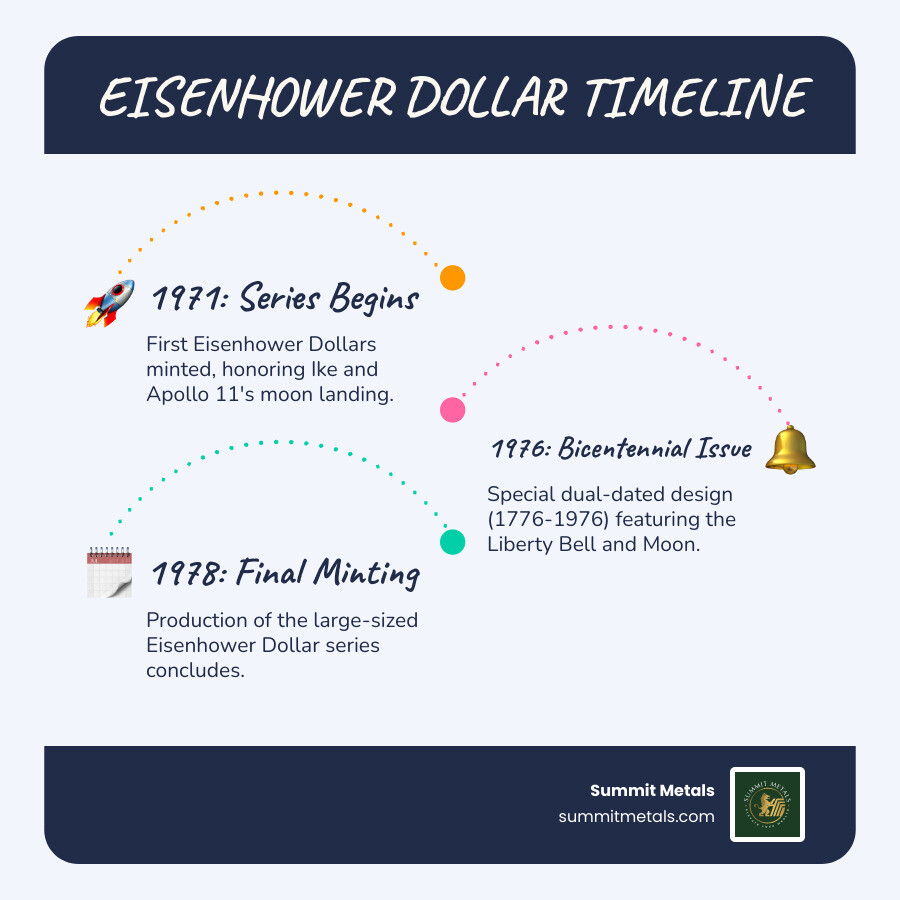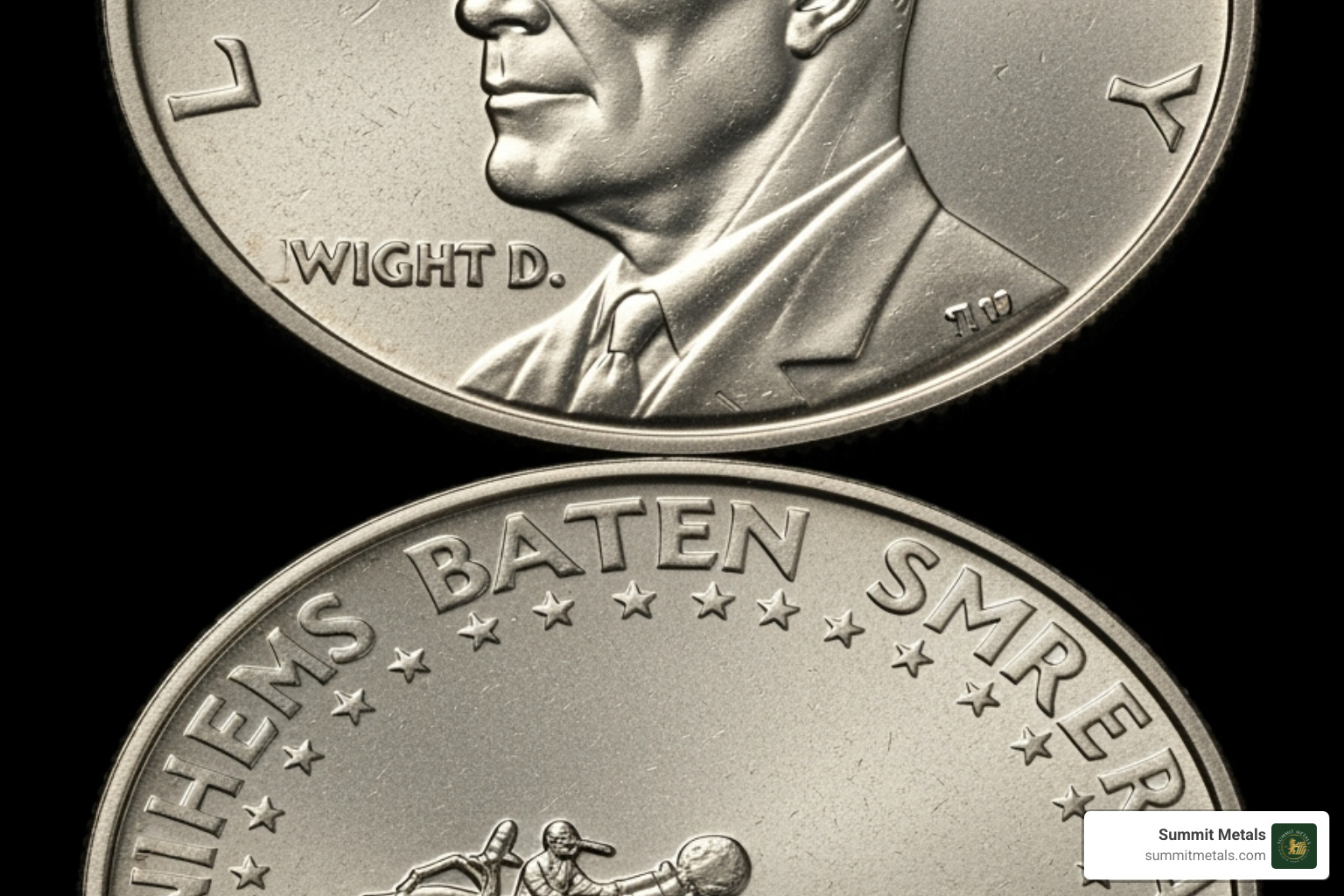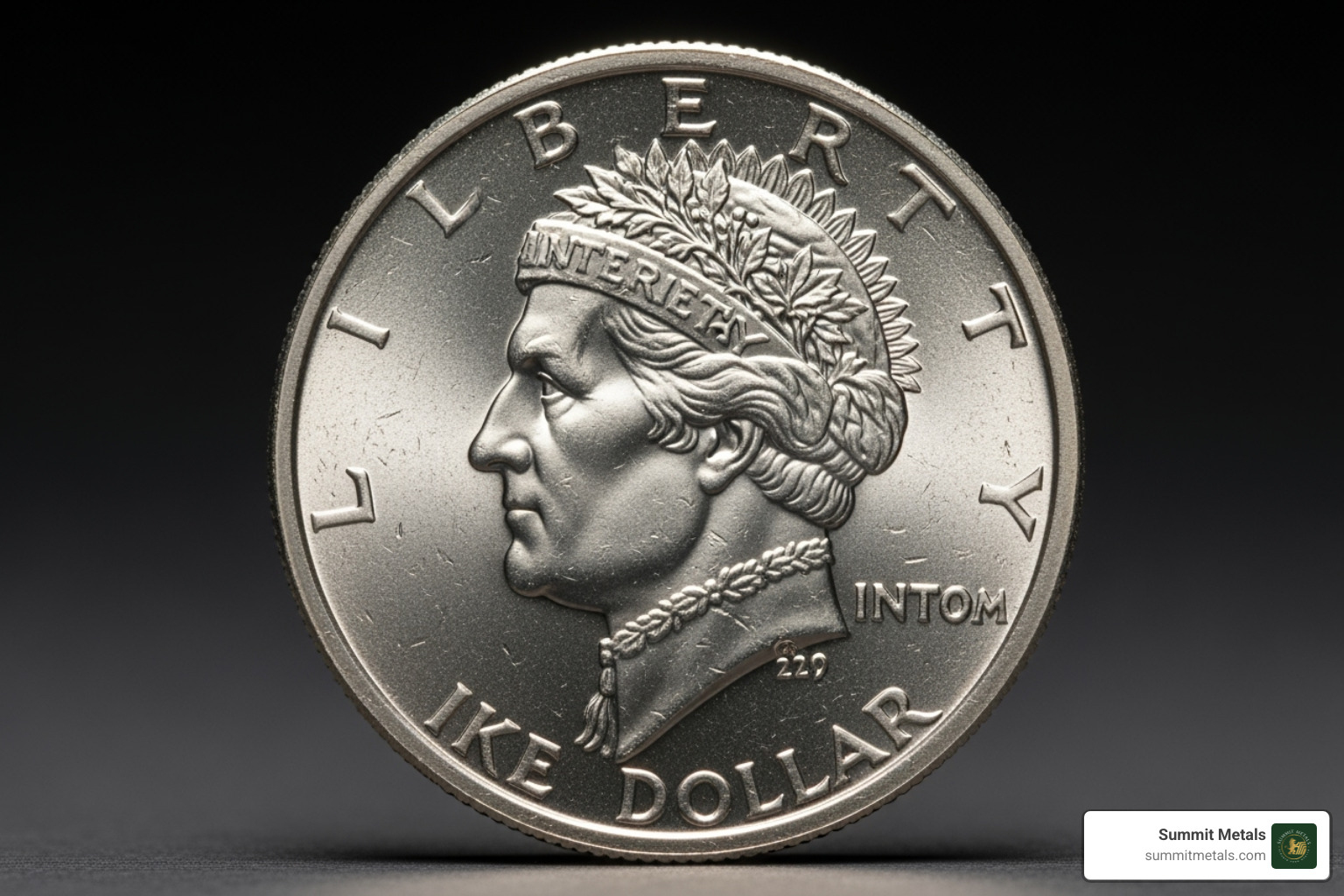Showing the Ike Silver Dollar: Your Essential Guide
If you've ever held an ike silver dollar, you might wonder about its history and value. This guide will tell you what you need to know.
Here’s a quick overview:
What is an Eisenhower (Ike) Dollar? It's a one-dollar coin from the U.S. Mint, produced from 1971 to 1978. It features President Dwight D. Eisenhower on the front and an eagle landing on the moon on the back. For 1975-1976, it had a special Bicentennial design.
Is my Ike Dollar made of silver? Most Ike Dollars for circulation are copper-nickel clad. However, special collector versions from the San Francisco Mint (with an 'S' mint mark) contain 40% silver.
How do I know if it's valuable? Value depends on its condition, mint mark, and whether it's a rare variety or error. The 40% silver versions are worth more than face value due to their silver content.
What are 'Blue Ikes' and 'Brown Ikes'? These are nicknames for the 40% silver collector versions. 'Blue Ikes' are uncirculated coins sold in blue envelopes. 'Brown Ikes' are proof coins sold in brown boxes.
What's a typical Ike Dollar worth? A common, circulated, non-silver Eisenhower Dollar is typically worth its face value or slightly more. For example, a 1972 Eisenhower Dollar in circulated condition is worth between $1.05 and $1.50. (Prices shown are at the time of this publication).
The Eisenhower Dollar, or Ike Dollar, holds a unique place in American coinage. It was the first dollar coin produced by the U.S. Mint since 1935 and the last large-sized dollar issued for general circulation. It served as a tribute to President Dwight D. Eisenhower and the Apollo 11 moon landing. These large coins never circulated widely, finding their main use in West Coast casinos, where they were often preferred over private tokens.
I'm Eric Roach, and my background on Wall Street and in precious metals gives me a unique perspective on understanding the value and market cycles of coins like the ike silver dollar. I focus on translating complex financial insights into clear, actionable guidance for investors like you.

The Story Behind the Coin: History and Design
The story of the ike silver dollar begins in 1969, a year marked by the passing of President Dwight D. Eisenhower and the triumph of the Apollo 11 moon landing. Congress decided to honor both events by creating a new dollar coin, the first from the US Mint since 1935. Chief Engraver Frank Gasparro was tasked with designing the coin, which was produced from 1971 to 1978.
This was a transitional period for U.S. coinage. After 1964, rising silver prices led the U.S. to move away from silver in its circulating coins. After a lengthy debate, Congress reached a compromise for the new dollar: most coins for everyday use would be a copper-nickel mix, while special 40% silver versions would be made for collectors. The large, heavy Ike Dollar never gained popularity for daily shopping but found a niche in Nevada casinos, where they were often used in place of gaming tokens. You can dive deeper into the full story on its Eisenhower dollar - Wikipedia page.
A Dual Commemoration
The Eisenhower Dollar tells two important stories. The front, or 'obverse', features a portrait of President Dwight D. Eisenhower, honoring his leadership in the post-WWII era. When you flip the coin, the 'reverse' side celebrates the incredible Apollo 11 moon landing. It's a fantastic way to remember both a respected leader and a huge leap for mankind.

The image on the back was inspired by the official Apollo 11 mission patch, a powerful symbol of human ingenuity. This coin is also notable as the last large-sized dollar coin the U.S. Mint made for everyday use, marking the end of an era for big, bold coins. Its creation was a clear sign of America's desire to commemorate important people and events on its currency.
Anatomy of the Ike Dollar
Let's explore the details of the ike silver dollar. The obverse design, by Frank Gasparro, proudly features President Dwight D. Eisenhower's profile. The word "LIBERTY" is curved above his head, with the motto "IN GOD WE TRUST" and the minting year below his portrait.
Now, flip it over to the reverse design, also by Gasparro. It shows a bald eagle landing on the moon, holding an olive branch as a symbol of peace. Earth is visible in the background, a reminder of the mission's origin. Around this scene are the words "E PLURIBUS UNUM," "UNITED STATES OF AMERICA," and "ONE DOLLAR." This design was adapted from the official Apollo 11 mission patch, cleverly connecting the coin to a major moment in American history. For more detailed info, you can check the Source Obverse and Reverse of the Eisenhower dollar coin. on PCGS.

Types and Compositions: Is Your Ike Dollar Made of Silver?
One of the most common questions about the Eisenhower Dollar is whether it's actually made of silver. The answer depends on the specific version of the coin.
While many refer to it as an ike silver dollar, only specific collector's versions contain silver. Most Eisenhower Dollars were made with a copper-nickel clad composition for circulation. However, the U.S. Mint also produced special editions with 40% silver content at the San Francisco Mint. This distinction is crucial for understanding your coin's value.
Clad vs. Silver: Understanding the Two Main Versions
The U.S. Mint created two different types of Eisenhower Dollars, and knowing the difference is key to determining its value.
Copper-Nickel Clad coins were intended for everyday use. These coins have outer layers of 75% copper and 25% nickel around a pure copper core. You can spot them by looking at the edge, where you'll see a reddish-brown copper stripe. The Philadelphia Mint (no mint mark) and Denver Mint ('D' mint mark) produced these coins.
40% Silver Clad coins were struck specifically for collectors. They have outer layers of 80% silver and 20% copper, with a core of 79% copper and 21% silver, for an overall composition of 40% silver. The telltale sign is a solid silver-colored edge with no copper stripe. The "edge test" is the quickest way to tell them apart.
The weight is also different: silver versions weigh about 24.59 grams, while clad coins weigh 22.68 grams. All 40% silver Eisenhower Dollars were minted in San Francisco and have an 'S' mint mark. Composition directly impacts a coin's intrinsic melt value. For more on how metal content influences value, see our guide on An Essential Guide to Valuing Constitutional Silver.
| Characteristic | Copper-Nickel Clad Ike Dollar | 40% Silver Clad Ike Dollar |
|---|---|---|
| Composition | Outer: 75% Cu, 25% Ni; Core: 100% Cu | Outer: 80% Ag, 20% Cu; Core: 79% Cu, 21% Ag (Overall 40% Ag, 60% Cu) |
| Weight | ~22.68 grams | ~24.59 grams |
| Edge Appearance | Reddish-brown stripe visible | Solid silver-colored edge |
| Common Mint Marks | P (Philadelphia), D (Denver) | S (San Francisco) |
The Collector's Choice: 'Blue Ikes' and 'Brown Ikes'
The 40% silver Eisenhower Dollars earned nicknames from their original packaging.
'Blue Ikes' are uncirculated 40% silver dollars sold in distinctive blue envelopes. The U.S. Mint packaged these coins in protective pliofilm inside the envelopes. They were sold from 1971 to 1974 and for the 1976 Bicentennial issue, originally priced at $3.
'Brown Ikes' are proof 40% silver dollars. Proof coins are struck with polished dies for a mirror-like finish and sharp detail. They came in brown faux wood grain boxes, giving them their nickname. The original price was $10, reflecting their premium quality.
Both Blue Ikes and Brown Ikes were struck at the San Francisco Mint and carry the 'S' mint mark. Their special packaging and lower mintage make them appealing to collectors.

The Bicentennial Issue (1776-1976)
For America's 200th birthday, the U.S. Mint issued a special Bicentennial ike silver dollar.
For 1975 and 1976, all Eisenhower Dollars featured a dual date "1776-1976" on the obverse. The reverse, designed by Dennis R. Williams, was changed to an image of the Liberty Bell superimposed on the moon. This design combined American history with space exploration. Interestingly, no Eisenhower Dollars are dated 1975; the Mint produced Bicentennial coins in both 1975 and 1976, but all carried the dual date.
Like regular issues, these Bicentennial coins were produced in both copper-nickel clad and 40% silver clad versions.

Valuing Your Ike Silver Dollar: From Face Value to Fortune
Determining the value of your ike silver dollar is a rewarding process. While many are worth little more than face value, factors like condition, variety, and composition can create a significant premium. Understanding these factors is key to open uping a coin's true potential.
The value of a collectible coin is a blend of its condition (grade), rarity, and collector demand. Mintage figures, key dates, varieties, and production errors can all boost a coin's price. For precious metals investors, it's important to distinguish between a coin's numismatic (collector) value and its melt value (the value of the metal itself). You can learn more in our guide on Spot Price vs. Premium: How Precious Metals Pricing Works.
Key Factors Influencing Value
When evaluating an Eisenhower Dollar, several critical elements determine its value:
- Metal Content: This is the biggest factor for an ike silver dollar. The 40% silver versions are intrinsically more valuable than copper-nickel clad coins because of their precious metal content. The silver melt value alone makes them worth significantly more than one dollar.
- Condition and Grade: A coin's condition, or grade, is crucial. Coins are categorized as "circulated" (showing wear) or "uncirculated" (like new). Professional grading services use numerical grades (e.g., MS-65 for Mint State) to denote preservation. An uncirculated coin is almost always worth more than a worn one of the same date. For example, a circulated 1972 Eisenhower Dollar might be worth $1.05 to $1.50, while a rare, uncirculated variety could be worth thousands. (Prices shown are at the time of this publication).
- Mint Mark Location: The small letter (P, D, or S) indicates where the coin was made and can affect its rarity. Philadelphia coins usually have no mint mark, Denver coins have a 'D', and San Francisco coins have an 'S'.
- Mintage Numbers: This is how many coins were produced for a specific year and mint. Lower mintage generally means higher rarity and value, assuming collector demand.
- Collector Demand: A coin's value also depends on how many collectors want it. Unique designs, historical connections, or interesting errors can create a buzz and drive up prices.
Key Dates and Varieties for the Ike Silver Dollar
While most Eisenhower Dollars are common, some dates and varieties stand out to collectors:
- 1973-S (Lowest Mintage): For the 40% silver ike silver dollar, the 1973-S issues (both uncirculated and proof) have the lowest mintage numbers in the series, making them highly desirable.
- "Friendly Eagle" Variety (1971-D): Some 1971-D dollars feature a reverse where the eagle appears less stern. This subtle difference makes these coins collectible.
- "Peg Leg 'R'" Variety (1971-S Proof): On some 1971-S proof coins, the left serif of the "R" in "LIBERTY" is missing, giving it a distinct look.
- Die Clashes: These occur when coin dies strike each other without a blank coin in between, leaving faint impressions of one side on the other. These are intriguing to variety collectors.
When searching through Ike Dollars, look for these varieties: the 1971-D Friendly Eagle, the 1971-S Peg Leg, the 1972 Type 1/2/3 Reverse (especially the rare Type 2), and the rare 1974/1977 Silver Clad Errors (a base-metal coin struck on a 40% silver blank).
The Holy Grails: High-Value Rarities
Within the Eisenhower Dollar series, a few coins are considered "holy grails" for their extreme rarity and high value:
- 1972 Type 2 Reverse (High Relief): This is a rare gem among 1972 Philadelphia-minted dollars. It features a clearer, bolder depiction of Earth on the reverse, with distinct islands off Florida's coast. It's believed they were struck with a proof die. Fewer than 40,000 are thought to exist. A 1972 D Silver Dollar (a different, though often confused, high-value coin) in perfect, uncirculated condition can sell for up to $2,000 (Prices shown are at the time of this publication).
- 1976 No 'S' Proof Silver Dollar: This is the most valuable Eisenhower Dollar. Only one known specimen exists of a 1976 Bicentennial proof dollar struck without the 'S' mint mark. This unique error coin is a numismatic anomaly. A 1976 No S Type 2 Silver Ike Dollar in PR66 condition is valued at an incredible $850,000 (Prices shown are at the time of this publication). This type of rarity is what makes coin collecting so exciting.
Frequently Asked Questions about the Ike Silver Dollar
Here are answers to some of the most common questions about the ike silver dollar.
How can I tell if my Eisenhower Dollar is silver?
To determine if your Eisenhower Dollar is silver, perform two simple checks:
First, look at the edge of the coin. A solid, uniform silver color indicates a 40% silver clad version. If you see a reddish-brown copper stripe, it's a non-silver, copper-nickel clad coin.
Second, check for the mint mark. All 40% silver Eisenhower Dollars were struck at the San Francisco Mint and have an 'S' mint mark on the obverse (front), below Eisenhower's neck. If your coin has no mint mark (Philadelphia) or a 'D' mint mark (Denver), it is a copper-nickel clad version with no silver content. An 'S' mint mark and a solid silver edge mean you have a silver Ike.
What is the rarest Eisenhower Dollar?
The rarest ike silver dollar is the 1976 No 'S' Proof Silver Dollar. Only one known example of this error coin exists. It was mistakenly struck at the San Francisco Mint without the 'S' mint mark, making it a true numismatic anomaly with an estimated value of $850,000. (Prices shown are at the time of this publication).
Other rare and sought-after varieties exist. The 1972 Type 2 clad dollar from Philadelphia is a key rarity, identified by its high-relief reverse design showing clear islands off Florida. For the 40% silver series, the 1973-S Eisenhower Dollars (both uncirculated and proof) have the lowest mintages, making them scarce and desirable for collectors.
Are 1776-1976 Bicentennial dollars valuable?
For the most part, 1776-1976 Bicentennial Eisenhower Dollars are not particularly valuable beyond their face value. The U.S. Mint produced them in massive quantities (over 200 million), so a regular, circulating copper-nickel clad Bicentennial Ike is likely worth just a dollar.
However, there are exceptions:
First, the 40% silver versions struck at the San Francisco Mint (with an 'S' mint mark) carry a premium due to their silver content. Their value depends on their condition and the current market price of silver.
Second, some Bicentennial Ikes have a Type 1 reverse, featuring sharper lettering. This variety is scarcer than the common Type 2 reverse and is sought by specialists.
Finally, any Bicentennial dollar in exceptionally high, uncirculated grade can fetch higher prices from collectors seeking to complete a high-grade set. While your typical Bicentennial Ike is a fun historical artifact, it's always worth checking for an 'S' mint mark and a solid silver edge.
Starting Your Ike Dollar Collection
The ike silver dollar series is an excellent entry point for new and experienced collectors. Its short run from 1971 to 1978 makes completing a set an achievable goal.
A major appeal of the Eisenhower Dollar is its affordability. You can often assemble a complete set of the common clad Ike Dollars without a large investment. Even the 40% silver versions are generally accessible. This allows you to focus on finding high-quality coins, exploring varieties, or collecting original government packaging, which adds another layer to the hobby. It's a series where you can experience the satisfaction of completing a set without breaking the bank.
From an investment potential standpoint, it's important to distinguish between common clad Ikes and their 40% silver counterparts. The silver versions offer a mix of numismatic interest and intrinsic metal value. Here at Summit Metals, based in Wyoming, USA, we specialize in authenticated gold and silver precious metals for investment and see how coins like the ike silver dollar can fit into a broader portfolio. Our commitment to transparent, real-time pricing and competitive rates means we're focused on building trust and value for investors in Wyoming, Utah, and across the globe.
The Eisenhower Dollar series offers a tangible piece of American history, bridging classic silver coinage with modern minting. Whether you're a new collector or a seasoned investor, these coins represent an engaging and rewarding field. If you're interested in the broader value of historic U.S. silver coinage, our guide to Constitutional Silver can provide valuable context. And whether buying or selling, it's always smart to know How to Buy Gold and Silver Online Safely. Happy collecting!






